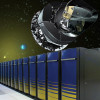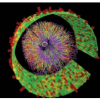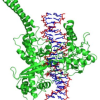Science News
Humanities and High Performance Computers Connect at NERSC
High performance computing and the humanities are finally connecting — with a little matchmaking help from the Department of Energy (DOE) and the National Endowment for the Humanities (NEH). Both organizations have teamed up to create the Humanities High Performance Computing Program, a one-of-a-kind initiative that gives humanities researchers access to some of the world’s most powerful supercomputers. Read More »
A Rising Tide of Cosmic Data
In 1998 the balloon-borne BOOMERANG and MAXIMA experiments made what were then the highest-resolution measurements of minute variations in the temperature of the cosmic microwave background radiation (CMB). Their high resolution was achieved by scanning small patches of the sky to gather unprecedented volumes of data. The analysis of these datasets presented a significant computational challenge – they were the first CMB datasets to require supercomputing resources. Read More »
IMPACTS: On the Threshold of Abrupt Climate Changes
Abrupt climate change is a potential menace that hasn’t received much attention. That’s about to change. Through its Climate Change Prediction Program, the U.S. Department of Energy’s Office of Biological and Environmental Research (OBER) recently launched IMPACTS – Investigation of the Magnitudes and Probabilities of Abrupt Climate Transitions – a program led by William Collins of Berkeley Lab’s Earth Sciences Division (ESD) that brings together six national laboratories to attack the problem of abrupt climate change, or ACC. Read More »
Visualizing the unseen forces of turbulence
Its invisible eddies and vortexes can dramatically alter the flight of everything from golf balls to hypersonic jets. Grasping the vast power of turbulence could help researchers design better weather forecasts, more efficient cars, quieter helicopters and even faster ships that “float” through the high seas on a cushion of air. Read More »
A Computer for the Clouds
A proposed supercomputer would do just one job--model global climate--but consume far less electricity than a general-purpose machine. Read More »
NERSC Helps STAR Researchers Find Evidence of Elusive Phenomena in Mountains of Experimental Data
With help from NERSC’s Parallel Distributed Systems Facility (PDSF) and High Performance Storage System (HPSS), the STAR collaboration is analyzing evidence for some of the most elusive phenomena in high energy physics — quarks, gluons, and proton spin.The STAR collaboration, 600 scientists from 52 institutions in 12 countries, studies the QCD phase diagram of nuclear matter and the origins of proton spin at the Relativistic Heavy Ion Collider (RHIC) at Brookhaven National Laboratory… Read More »
Sandia Researchers Are Creating Benchmarks for Combustion Strategy
Two Sandia National Laboratories scientists at the Combustion Research Facility are using NERSC resources to create a benchmark data set for modeling combustion physics relevant to the next generation of internal combustion engines, an undertaking that will benefit the development of efficient engines running on alternative fuels.Ed Richardson and Jackie Chen will develop three-dimensional simulations of combustion representing the stratified conditions that may be useful when developing… Read More »
Code Booster: Award-winning research on code optimization explores multicore computing
At the 2008 IEEE International Parallel and Distributed Processing Symposium (IPDPS) held in Miami, the award for Best Paper in the “applications” category went to a research paper exploring ways to make a popular scientific analysis code run smoothly on different types of multicore computers. Read More »
A Supercomputer Takes Humanities Scholars Into the 21st Century
The phrase "one million" in grant announcements tends to be eye-catching because it is usually linked to the word "dollars." But late Monday afternoon, when officials at the National Endowment for the Humanities used that figure in describing a new grants program, they were not talking about money. "We are offering one million hours of high-performance computing," said Brett Bobley, director of the endowment's new Office of Digital Humanities.... Read More »
Ceramic, Heal Thyself
A new computer simulation has revealed a self-healing behavior in a common ceramic that may lead to development of radiation-resistant materials for nuclear power plants and waste storage. DOE's Office of Basic Energy Sciences funded the research, which was performed on massively parallel supercomputers in the William R. Wiley Environmental Molecular Sciences Laboratory (EMSL) at PNNL, and the National Energy Research Scientific Computer Center at Lawrence Berkeley National Laboratory. Read More »
Nano-Behavior
A team from the University of California at Irvine is exploring the complex interactions of human DNA with proteins and nanoparticles in a research that tackles key problems in designing and delivering anti-cancer drugs and gene therapy. The research team, headed by Ioan Andricioaei, is using the computer power and services at NERSC to better understand how certain proteins affect DNA’s behavior during cell replication. The research also looks at the dynamics between DNA and… Read More »
Green Computing
NERSC and other Berkeley Lab researchers are taking on energy efficiency research that aims to influence the computing industry in designing and building computer and storage technologies that will benefit the scientists, consumers and the environment. Thanks to the Laboratory Directed Research and Development Program (LDRD) at Berkeley Lab, researchers are exploring subjects in computer architectures, algorithms and mass storage system designs to improve energy efficiency … Read More »











